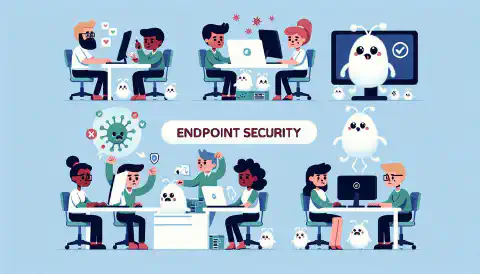Empower Your Defense: Exploring EDR Cyber Security Solutions

Table of Contents
Understanding EDR Cyber Security Solutions
Endpoint Detection and Response (EDR) solutions are becoming increasingly crucial in today’s digital landscape. As cyber threats continue to evolve and become more sophisticated, organizations must adopt robust security measures to protect their sensitive data and systems. In this article, we will explore what EDR cyber security is, its key features, the benefits of implementing EDR solutions, and how to choose the right one for your business.## What is EDR Cyber Security?
Endpoint Detection and Response (EDR) cyber security is an advanced security approach that focuses on detecting, investigating, and responding to threats at the endpoint level. In today’s increasingly complex threat landscape, traditional security solutions such as firewalls and antivirus software are vital but not sufficient. EDR solutions provide organizations with real-time visibility into endpoint activities and enable proactive threat detection and response.
But what exactly does endpoint mean in the context of EDR? Endpoints refer to devices such as laptops, desktops, and mobile devices that are connected to a network. These devices are often vulnerable to various threats, including malware, ransomware, and phishing attacks. EDR solutions step in to monitor endpoint behavior, analyze data for anomalies, and provide actionable insights to security teams.
EDR solutions employ a combination of technologies, such as behavioral analysis, machine learning, and threat intelligence, to identify and mitigate potential threats. By continuously monitoring endpoint activities, EDR solutions can identify indicators of compromise (IoCs) and perform real-time threat hunting. This proactive approach helps organizations stay one step ahead of cybercriminals.
The Basics of Endpoint Detection and Response
Endpoint Detection and Response solutions operate on the premise that the endpoint is the first line of defense against cyber attacks. By focusing on endpoints, EDR solutions aim to strengthen an organization’s overall security posture. These solutions provide security teams with the necessary tools and capabilities to detect and respond to threats effectively.
One of the key features of EDR solutions is their ability to provide real-time visibility into endpoint activities. This visibility allows security teams to monitor and analyze the behavior of endpoints, enabling them to detect any suspicious or malicious activities. By identifying potential threats at an early stage, organizations can take immediate action to prevent further damage.
EDR solutions also leverage advanced technologies to enhance threat detection and response capabilities. Behavioral analysis, for example, enables EDR solutions to establish a baseline of normal endpoint behavior and identify any deviations from that baseline. Machine learning algorithms can then analyze these deviations and determine whether they indicate a potential threat.
Furthermore, EDR solutions make use of threat intelligence, which involves gathering and analyzing information about known threats and attack techniques. By continuously updating their threat intelligence databases, EDR solutions can quickly identify and respond to emerging threats.
Importance of EDR in Today’s Digital Landscape
In recent years, cyber attacks have grown in frequency and sophistication, making it essential for organizations to adopt advanced security measures. With the increasing number of remote workers and reliance on cloud services, endpoints have become a prime target for cybercriminals. EDR solutions play a critical role in protecting these endpoints and the sensitive data they contain.
By leveraging EDR solutions, organizations can enhance their overall security posture. Real-time insights into endpoint activities enable security teams to detect advanced threats that traditional security tools might miss. EDR solutions empower organizations to automate incident response processes, allowing for faster and more effective mitigation of cyber attacks.
Additionally, EDR solutions provide organizations with valuable forensic capabilities. In the event of a security incident, EDR solutions can provide detailed information about the attack, including the timeline of events, affected endpoints, and the techniques used by the attackers. This information is crucial for conducting thorough investigations and implementing measures to prevent future attacks.
In conclusion, EDR cyber security is a critical component of a comprehensive security strategy. By focusing on endpoints and employing advanced technologies, EDR solutions enable organizations to detect, investigate, and respond to threats in real-time. In today’s digital landscape, where cyber attacks are a constant threat, EDR solutions are essential for safeguarding sensitive data and maintaining the integrity of organizational networks.
Key Features of EDR Cyber Security Solutions
EDR cyber security solutions offer a wide range of features and capabilities that enable organizations to protect their endpoints and mitigate the risks posed by cyber threats. Here are some key features to consider:
Real-Time Threat Detection
EDR solutions continuously monitor endpoints in real-time, analyzing system behavior and network traffic to identify potential threats. By leveraging advanced threat detection techniques, such as machine learning and behavioral analytics, EDR solutions can detect both known and unknown threats.
Furthermore, EDR solutions employ threat intelligence feeds and sandboxing to identify and block malicious files and activities. This proactive approach allows organizations to stay one step ahead of cyber attackers and minimize damage.
For example, when an EDR solution detects suspicious behavior on an endpoint, it can immediately analyze the network traffic associated with that endpoint to identify any potential threats. It can then take action to isolate the affected endpoint and prevent the threat from spreading to other parts of the network.
Automated Response Capabilities
EDR solutions streamline incident response processes by automating various security tasks. When a potential threat is detected, EDR solutions can trigger automatic responses, such as isolating the affected endpoint, terminating malicious processes, or blocking suspicious network connections.
This automation not only saves time but also reduces the burden on security teams, enabling them to focus on more critical tasks, such as threat investigation and remediation.
For instance, if an EDR solution detects a file that matches a known malware signature, it can automatically quarantine the file and initiate a scan on the affected endpoint to identify any other potential threats. This automated response ensures that organizations can quickly contain and neutralize cyber threats, minimizing the impact on their systems and data.
Integration with Other Security Tools
EDR solutions can integrate seamlessly with other security tools, such as Security Information and Event Management (SIEM) systems and Security Orchestration, Automation, and Response (SOAR) platforms. This integration enables organizations to centralize security operations, correlate data from different sources, and automate incident response workflows.
By integrating EDR with other security tools, organizations can have a holistic and coordinated approach to security, enhancing their overall threat detection and response capabilities.
For example, when an EDR solution detects a potential threat, it can automatically send an alert to the SIEM system, which can then correlate the threat information with other security events and provide a comprehensive view of the organization’s security posture. This integration allows security teams to quickly prioritize and respond to threats based on their potential impact.
In addition, EDR solutions can integrate with SOAR platforms, which can orchestrate and automate incident response workflows. This integration enables organizations to define and execute standardized response actions, ensuring a consistent and efficient approach to handling security incidents.
Overall, the integration of EDR with other security tools enhances the organization’s ability to detect, respond to, and remediate cyber threats effectively.
Benefits of Implementing EDR Solutions
The implementation of EDR solutions offers several benefits that help organizations strengthen their cybersecurity posture and mitigate the risks associated with modern cyber threats.
As cyber threats continue to evolve and become more sophisticated, organizations need robust protection measures in place to safeguard their sensitive data and infrastructure. EDR solutions provide organizations with enhanced protection against a wide range of cyber threats, including malware, ransomware, and fileless attacks. By actively monitoring endpoint activities and utilizing advanced threat detection techniques, EDR solutions help organizations detect and respond to threats in real-time, minimizing the potential damage.
Furthermore, EDR solutions enable security teams to gain valuable insights into the tactics, techniques, and procedures (TTPs) employed by cyber attackers. By analyzing the behavior and patterns of malicious actors, security teams can develop proactive defense strategies and stay one step ahead of potential threats.
Enhanced Protection Against Cyber Threats
EDR solutions provide organizations with robust protection against a wide range of cyber threats, including malware, ransomware, and fileless attacks. By actively monitoring endpoint activities and utilizing advanced threat detection techniques, EDR solutions help organizations detect and respond to threats in real-time, minimizing the potential damage.
Furthermore, EDR solutions enable security teams to gain valuable insights into the tactics, techniques, and procedures (TTPs) employed by cyber attackers, empowering them to develop proactive defense strategies. By understanding the methods used by malicious actors, organizations can better protect their systems and data.
With the increasing complexity and volume of cyber threats, organizations need comprehensive security solutions that can adapt and respond to emerging risks. EDR solutions offer organizations the ability to stay ahead of evolving threats by continuously monitoring and analyzing endpoint activities. This proactive approach to cybersecurity helps organizations identify and mitigate potential vulnerabilities before they can be exploited by attackers.
Improved Incident Response Times
In the event of a security incident, time is of the essence. EDR solutions facilitate rapid incident response by automating various security tasks, such as threat detection, investigation, and remediation. This automation reduces response times, enabling security teams to contain and remediate incidents before they escalate.
Additionally, EDR solutions provide detailed forensic data and facilitate post-incident analysis, helping organizations understand the root cause of security incidents. By gaining insights into the attack vectors and techniques used by attackers, organizations can strengthen their overall security posture and implement measures to prevent similar incidents in the future.
Furthermore, the ability to quickly detect and respond to security incidents can help organizations minimize the impact of a breach. By containing and remediating incidents promptly, organizations can prevent the exfiltration of sensitive data and mitigate potential financial and reputational damage.
Cost-Effective Security Management
Implementing EDR solutions can contribute to cost-effective security management. By automating security tasks and streamlining incident response processes, organizations can optimize the use of their security resources.
EDR solutions also help organizations reduce the risk of data breaches and the associated financial implications. Detecting and responding to threats at the endpoint level helps prevent data exfiltration and potential regulatory penalties. By investing in EDR solutions, organizations can potentially save significant costs that would otherwise be incurred in the aftermath of a data breach.
Moreover, EDR solutions provide organizations with valuable insights into their security posture and vulnerabilities. By analyzing endpoint data and identifying potential weaknesses, organizations can allocate their resources more effectively and prioritize security measures based on the identified risks.
In conclusion, the implementation of EDR solutions offers numerous benefits to organizations. From enhanced protection against cyber threats to improved incident response times and cost-effective security management, EDR solutions play a crucial role in strengthening an organization’s cybersecurity posture and mitigating the risks associated with modern cyber threats.
Choosing the Right EDR Solution for Your Business
Choosing the right EDR solution for your business requires careful evaluation of your security needs, thorough vendor comparison, and understanding of pricing and licensing models.
Assessing Your Security Needs
Before selecting an EDR solution, it is essential to assess your organization’s security needs. Consider factors such as the size of your organization, the complexity of your network environment, and the types of endpoints you need to protect.
Additionally, evaluate the scalability of the EDR solution to ensure it can accommodate your future growth. Assess your specific compliance requirements and determine if the EDR solution aligns with industry regulations and standards.
Comparing Different EDR Vendors
When comparing different EDR vendors, consider factors such as the vendor’s reputation, experience in the cybersecurity industry, and customer reviews. Evaluate the vendor’s track record in detecting and responding to emerging threats.
Pay attention to the functionality and usability of the EDR solution, as well as the quality of customer support provided. Request demonstrations or trials to assess the solution’s effectiveness in your specific environment.
Understanding Pricing and Licensing Models
Pricing and licensing models can vary significantly among EDR vendors. Carefully review the pricing structures to ensure they align with your budget and provide the required functionalities.
Consider factors such as the number of endpoints covered, available support levels, and any additional costs for advanced features or integrations. Opt for a pricing model that offers flexibility and scalability as your organization grows.
Conclusion
Overall, implementing EDR cyber security solutions is crucial in today’s digital landscape. By understanding what EDR is, exploring its key features, and assessing its benefits, organizations can make informed decisions and strengthen their cybersecurity posture. Selecting the right EDR solution and leveraging its capabilities effectively can significantly enhance an organization’s ability to detect, respond to, and mitigate cyber threats.






